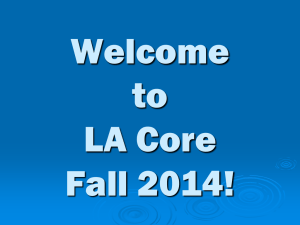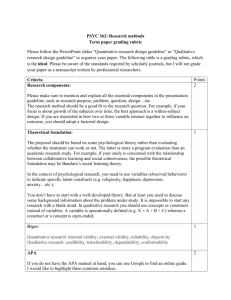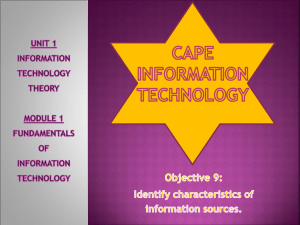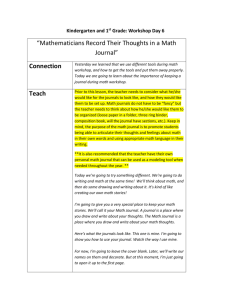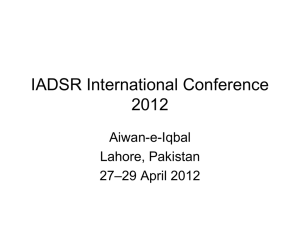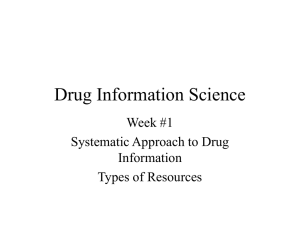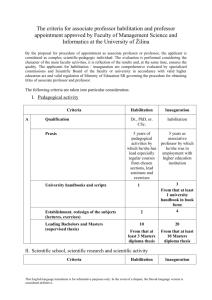REPORT OF STUDY VISIT TO FINLAND 14 May to 10 June 2012
advertisement
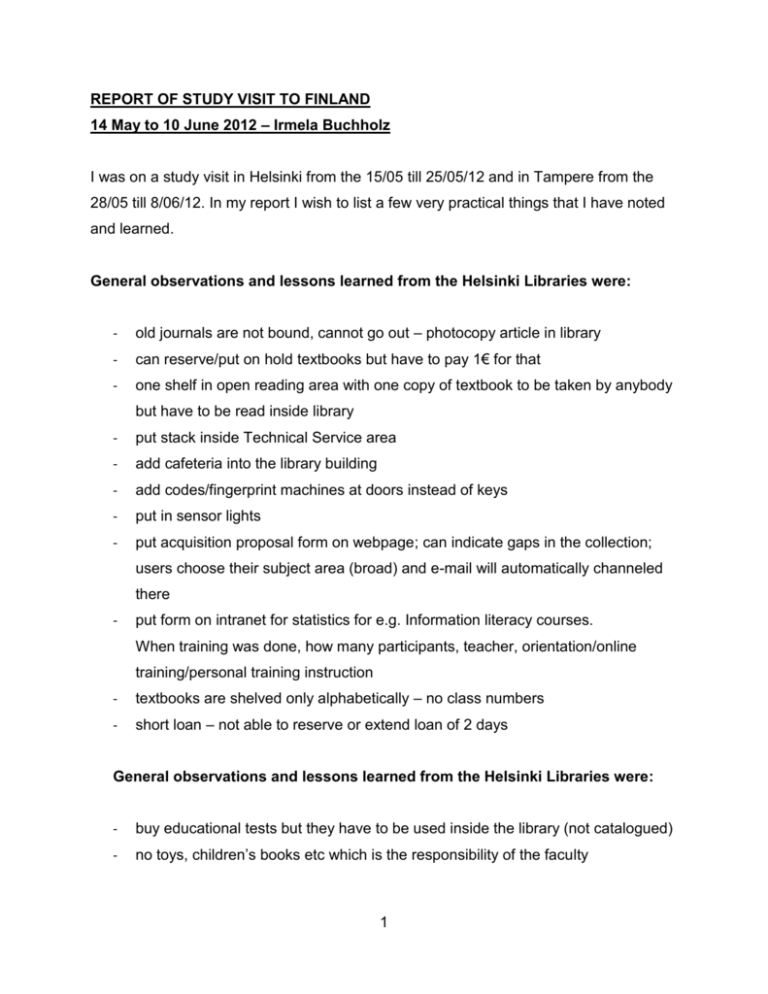
REPORT OF STUDY VISIT TO FINLAND 14 May to 10 June 2012 – Irmela Buchholz I was on a study visit in Helsinki from the 15/05 till 25/05/12 and in Tampere from the 28/05 till 8/06/12. In my report I wish to list a few very practical things that I have noted and learned. General observations and lessons learned from the Helsinki Libraries were: - old journals are not bound, cannot go out – photocopy article in library - can reserve/put on hold textbooks but have to pay 1€ for that - one shelf in open reading area with one copy of textbook to be taken by anybody but have to be read inside library - put stack inside Technical Service area - add cafeteria into the library building - add codes/fingerprint machines at doors instead of keys - put in sensor lights - put acquisition proposal form on webpage; can indicate gaps in the collection; users choose their subject area (broad) and e-mail will automatically channeled there - put form on intranet for statistics for e.g. Information literacy courses. When training was done, how many participants, teacher, orientation/online training/personal training instruction - textbooks are shelved only alphabetically – no class numbers - short loan – not able to reserve or extend loan of 2 days General observations and lessons learned from the Helsinki Libraries were: - buy educational tests but they have to be used inside the library (not catalogued) - no toys, children’s books etc which is the responsibility of the faculty 1 - put barcode of book on back cover otherwise self-help return system is not going to work - scan license agreements and put on network/intranet Acquisition - 80% of budget goes to electronic resources - 12% print books - 8% print journals 15% of whole budget goes to textbooks. At both libraries all resources (print, electronic, serials, books) coming out of one budget vote. Not every department and faculty has the same needs – some need rather journals than books – therefore it is better to have one budget not separate book and journal budget. The libraries do not divide budget in departmental funds but rather type of resource. At Tampere University Library it takes ± 38 days to receive a book from vendor (outside Finland. Libraries use Amazon for out-of print books. Multiple copies are bought with exceptions only for textbooks (prescribed books); not more than 25 copies; 1 book for every 5 students if no e-book is available; separate textbook reading room. Faculties have to approve; have to fill in online order form; have to order 6 months before classes start; have to indicate how many students in class. For textbooks order paperback copies. Tender process: every 4 years do a tender process to decide which vendor is the cheapest; bargain for discount for multicopies. E-Books Most important criteria when ordering e-books are: IP authentication - if using also shibboleth is it compatible with our university’s system 2 Remote access must be possible Simultaneous users – important for textbooks only; multi user means different things in different platforms, make sure beforehand Fees: annual or others (MyiLibrary has annual fee even if you don’t order anything and you are bound to pay it if you want to keep the books ordered in previous years) Ordering system Interface for the users point of view – does it allow you to make notes, underline, preserve notes, how much printing and copying is allowed Tampere made research – only 13% of textbooks are currently available in e-format Students still prefer print copies (started with e-books in 2002). Stats shows that the most downloads are ca 14 times for the same title; most of the titles are only used once. Don’t use too many platforms as users have to login to different systems if using books from different platforms. Mostly all books are available in all of the platforms. License agreements/FinELib - Have a page of user terms and conditions as users have to be informed about the license details. - availability of statistics must be in license agreement - end user is the most important thing in agreement - perpetual (permanent) access usually only works with publishers directly not aggregators - must have IP authentication - for how long is the transaction signed – one year, 2? - can the agreement be cancelled? - remote access must be possible 3 Risk management Steps that can be taken to minimize risk management in TS is to write manuals of all the various work areas and put them into the library’s intranet for everybody to use and to understand how work is done; create substitutes for everyone; keep instructions updated. Collection mapping/evaluation The Library can decide at what level to do the mapping. Don’t go into too much detail but rather use broad classes. Tampere is taking one or two subject area per year. Process is cooperation between subject librarians, people doing the stats for print collections, people doing stats for e-resources. When finished with report invite the departments to see the results and maybe also indicate certain trends or explain certain patterns. The map will help in collection development included weeding. Focus areas within a certain subject (e.g. developmental and child psychology, cognitive psychology, personality psychology, counseling in psychology) will give an indication of which areas should be developed more. The collection mapping report should include: Background information about subject area Background about date, reason of mapping and where and when Shelf scanning to have general impression Reference collection; Print books; Print journals ; Most used print journals; E-books; Ejournals; Most used e-journals; E-databases Age distribution of monographs and usage statistics Language distribution of monographs and usage statistics Interpretation of the above Focal areas of monograph collection 4 Collection development implications Journals print In order to receive statistics for print journals make list of all print journals on Excel and mark everyday which ones were shelved; use the 4 busiest months of the year. If a 2010 journal was shelved in 2012, put in on 2012s list. The same list can be used for budget information (not adding of holdings); gives good indication of growth in price as well as if paid and when etc. Follow-up usage and if statistics show that the title is not used it is a reason to cancel. Do not order new print journals without talking with customer about usage as it is a longterm commitment. Conclusion The time in Finland was an unbelievable positive experience. It is not only the work related practices that I as well as the UNAM Library gained but also the personal encounters with the Finnish colleagues that were very accommodating, at all times made time for my enquiries, always were friendly and a lot of them spend their personal time and money to invite me or show me around. I am sure that with the experiences gained, fruitful changes can be made at UNAM Library for a better and more sufficient service for our customers. 5
